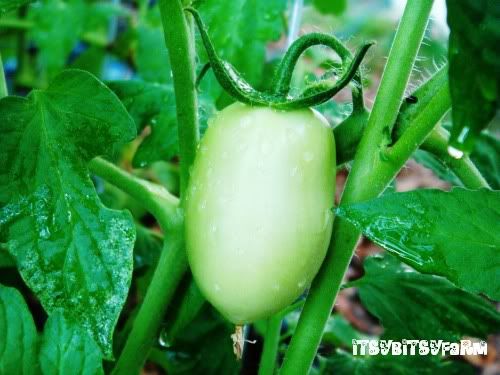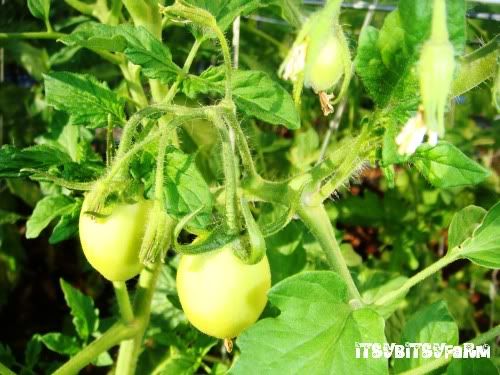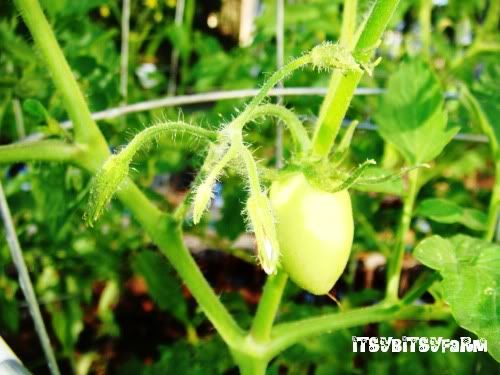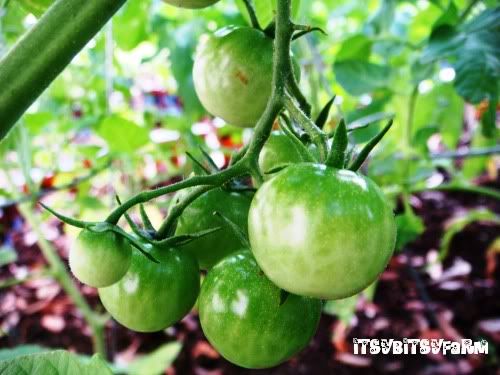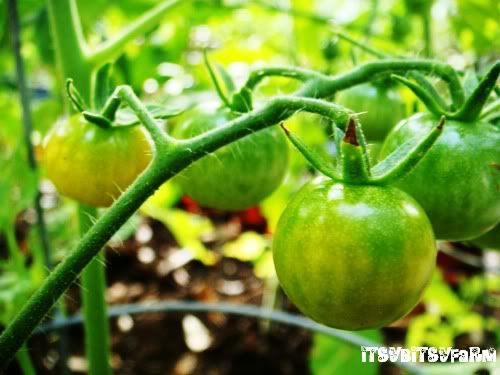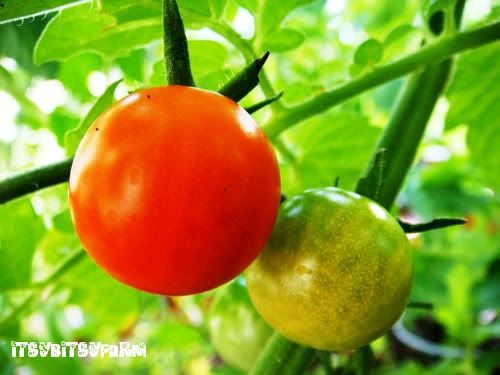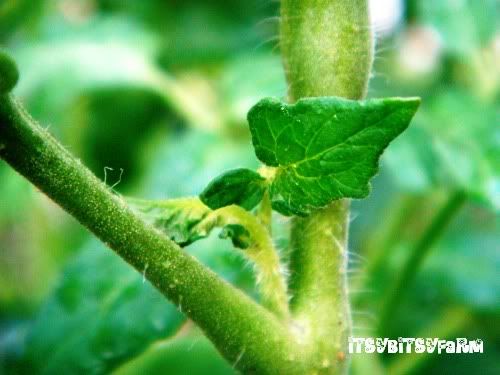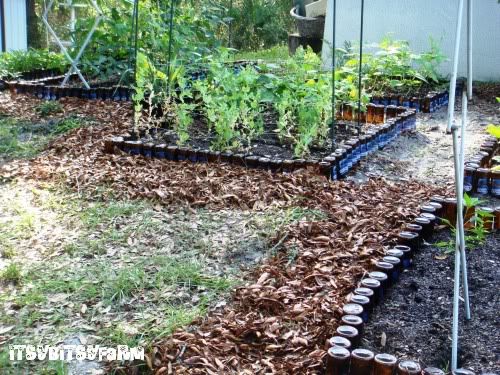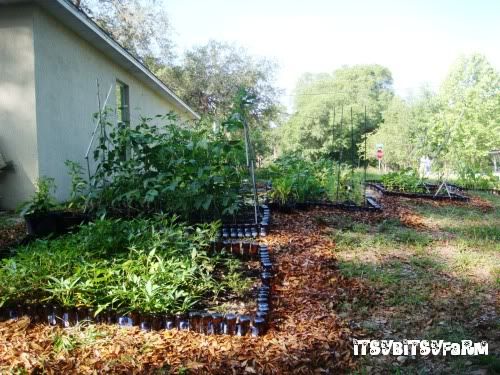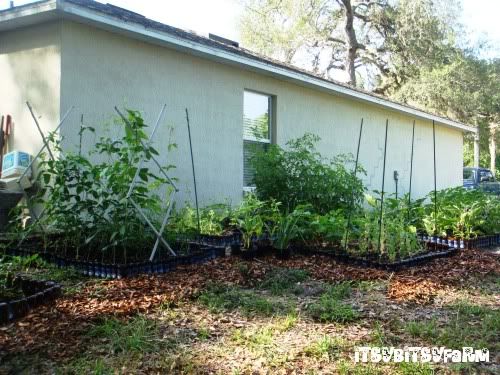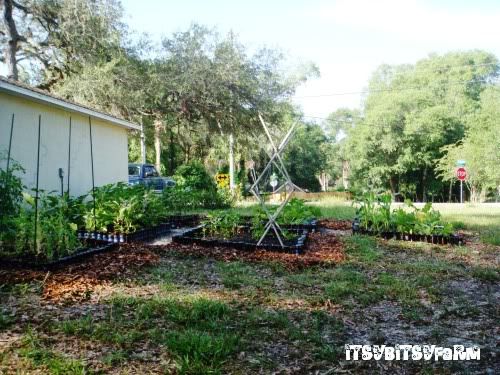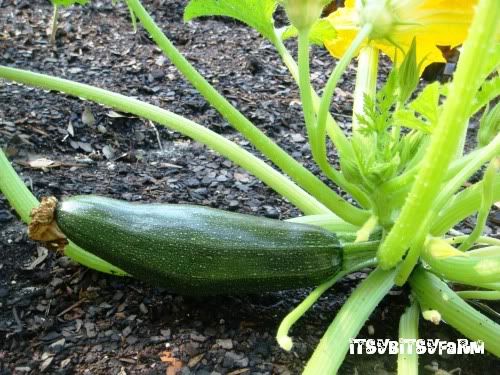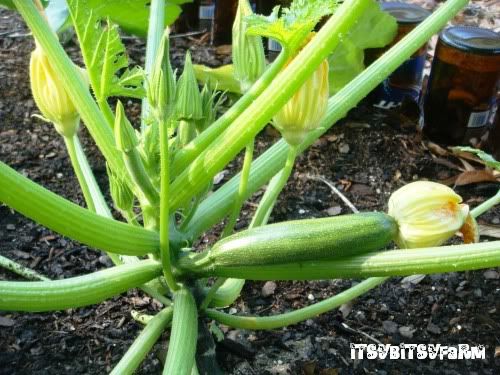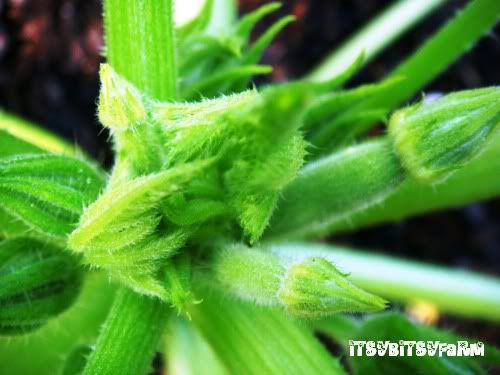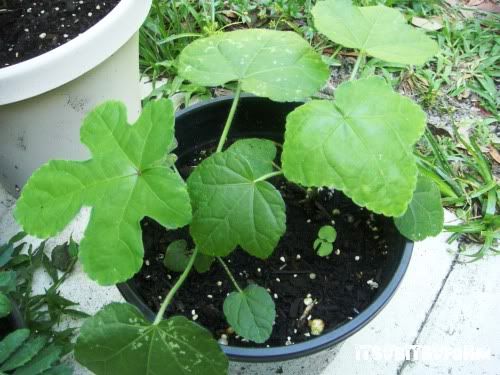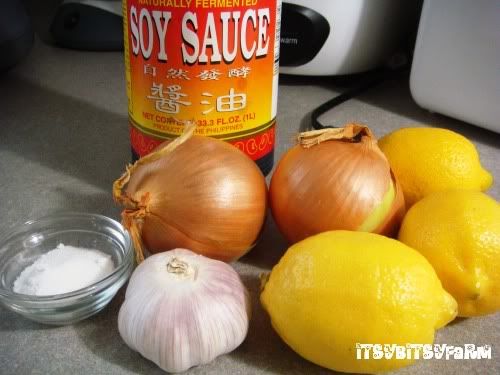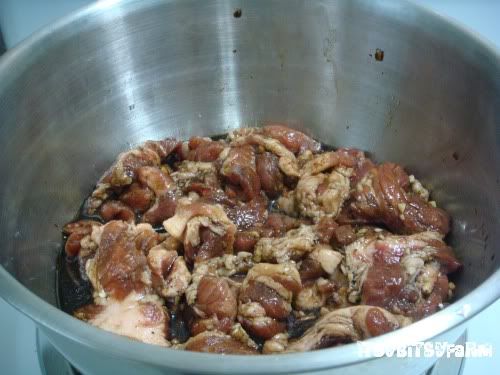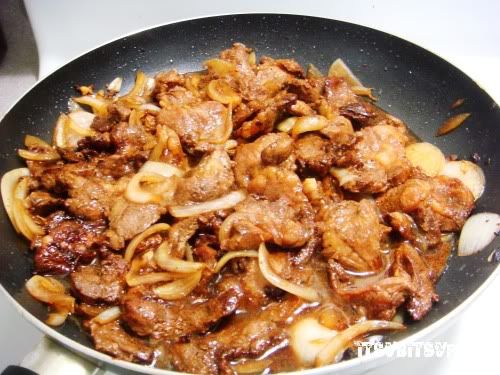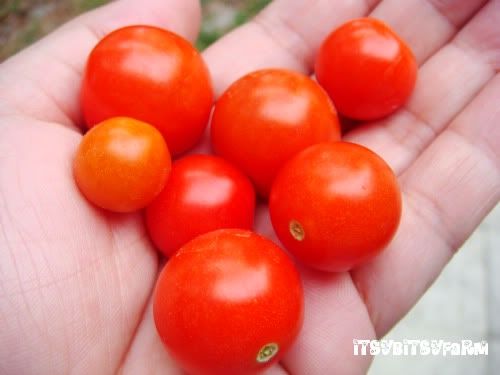 |
| my daily pick of cherry tomatoes |
tomatoes in my garden
The roma tomatoes are a bit selfish in giving out fruit this season. The cherry tomatoes, on the other hand, couldn't be much happier in welcoming me to the garden—they're multiplying like rabbits.
die, you suckers!
I’ve had very few successes in growing tomatoes. Then and now, I have way too few fruit on my plants. I've got about four roma tomato plants but so far, I only have a handful of fruit.
After I’ve spoken with another backyard tomato grower over the weekend, I realized my own tomatoes’ problems: too much foliage, so not much fruit.
Crawling through Google’s motley advice on proper tomato pruning, I found that pruning yields more and larger fruits.
The expert tomato growers also say that it’s best to prune early, when the potential problem stems are just tinny weenie suckers. So as I go through my tomatoes, I found myself crying out, “Die, you suckers!” without the guilt and with all satisfaction, heh.
One advice I discovered says to keep tomatoes free of these side stems beneath the first fruit cluster but since I’ve pretty much left my tomatoes to their own devices, the profusion of foliage can’t be solved by simply pinching off the suckers.
This time, I had to do some major snipping. Where there were bigger (and leafy) side stems, I had to cut down to the first couple of leaves on the side stem. I hear it’s best so as to prevent trauma to the plant.
I hope all the pinching off and snipping didn’t traumatize my tomato plants though. I’ll have to look see tomorrow afternoon, after they’ve withstood the hot weather. Hope the pruning don’t get them sun-scalded.
After I’ve spoken with another backyard tomato grower over the weekend, I realized my own tomatoes’ problems: too much foliage, so not much fruit.
Crawling through Google’s motley advice on proper tomato pruning, I found that pruning yields more and larger fruits.
The expert tomato growers also say that it’s best to prune early, when the potential problem stems are just tinny weenie suckers. So as I go through my tomatoes, I found myself crying out, “Die, you suckers!” without the guilt and with all satisfaction, heh.
One advice I discovered says to keep tomatoes free of these side stems beneath the first fruit cluster but since I’ve pretty much left my tomatoes to their own devices, the profusion of foliage can’t be solved by simply pinching off the suckers.
This time, I had to do some major snipping. Where there were bigger (and leafy) side stems, I had to cut down to the first couple of leaves on the side stem. I hear it’s best so as to prevent trauma to the plant.
I hope all the pinching off and snipping didn’t traumatize my tomato plants though. I’ll have to look see tomorrow afternoon, after they’ve withstood the hot weather. Hope the pruning don’t get them sun-scalded.
tiny farm, circa may 2012
Here’s a look at my itsy bitsy farm for May 2012.
All the plants are robustly growing and as you can see I’ve managed to mulch the peripheries with dried oak leaves. Now, the next step is mulching the aisles. I’m thinking a hundred times about mulching the beds though.
All the plants are robustly growing and as you can see I’ve managed to mulch the peripheries with dried oak leaves. Now, the next step is mulching the aisles. I’m thinking a hundred times about mulching the beds though.
first zucchinis
I’ve got zucchinis in my garden, the
closest I can come to the Pinoy patola (or luffa). I plan to have the luffa
variety this coming September season. In the meantime, we’ll make do with what
we have right now. :)
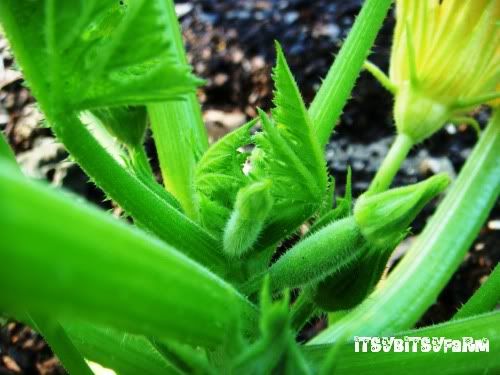 |
| more zucchinis coming up... |
 |
| first harvest of zucchinis, cherry tomatoes and bitter gourd |
a delightful surprise
Our side yard is a wide expanse of weeds, grass, and wildflowers. One midday walk in my garden, I happened to see a lonely plant in a sea of weeds and grass, sporting brightly-hued flowers.
My first instinct was to dismiss it as a wildflower, but something about the beauty of the blooms drew me close. When I got near, what do you know! It’s one of those lantana colors I’ve been wanting to have.
To tell you frankly, there’s a dense jungle of trees and bushes near Cousin A’s place and at the edge, wild lantana bushes are thriving robustly. I’ve been meaning to, er, steal some cuttings but I was too shy to creep up to it and snip me some, heh.
Once I saw these beauties, I immediately saved me some branches for my island garden. :)
My first instinct was to dismiss it as a wildflower, but something about the beauty of the blooms drew me close. When I got near, what do you know! It’s one of those lantana colors I’ve been wanting to have.
Once I saw these beauties, I immediately saved me some branches for my island garden. :)
what plant is this?
I got the seeds of this heretofore unknown plant from a friend’s house. It’s got pink blooms, has soft brown branches, grows like a shrub, dies in winter but returns in spring. What is it?
Until it flowers, I won't be able to identify it. Le sigh...
Until it flowers, I won't be able to identify it. Le sigh...
pinoy bistek recipe
One of my favorite(st) home cooked meals is Pinoy Bistek, the Filipino version of a beef steak dish. Thing is, Pinoys love sabaw (soup/runny generous sauce) so Bistek gives a nod to that penchant by allowing cooks to add a li’l bit of it in a beef steak dish.
The Bistek I love best is the one prepared by my BFF’s brother-in-law Kiko. It’s got that right balance of saltiness and tang that makes drenching hot steamy rice in Bistek sauce the best gustatory delight ever.
I’ve probably tried about 20 times to replicate Kiko’s recipe (which he’s been meaning to share but couldn’t get ‘round to it). After the nth try, I think I’ve got it.
Bistek is ordinarily prepared with calamondin (kalamansi), a much more acidic citrus that’s native to the Philippines, but this recipe calls for lemon juice. The resulting Bistek approximates that of the one you’d have if you prepared it with kalamansi...but not quite. Still, it’s got the taste that I like so I’m happy. (And I've served this in no less than two parties and the dish received a rousing welcome—both from American and Pinoy audiences—so I think others liked it, too!)
Pinoy Bistek Recipe
2.5 lbs chuck roast beef, sliced thinly
2/3 c dark soy sauce
Juice of 4 lemons
6 cloves garlic, minced
1 T vegetable oil
1 t ground pepper
2 t sugar
2 T vegetable oil
1 large onion, sliced into rings
2 large onions, halved and sliced thickly
- Prepare the beef by washing it thoroughly, then drying it just as well with paper towels. Once dry, slice the chuck roast into thin, steak slices.
- Mix the soy sauce, lemon juice, minced garlic, vegetable oil, ground pepper and sugar in a bowl. Marinade the beef, then cover the bowl with cling wrap. Let it sit in the refrigerator for about 30 minutes to 1 hour.
- Once the beef is ready, heat a skillet with the remaining vegetable oil and fry the beef slices until brown, about 4 minutes each side. Remove the cooked beef from the skillet and place in another bowl.
- When all the beef slices have been fried, sautee the onion rings in the same oil for about a minute or until half cooked. Transfer to a bowl. You’ll use this to top the beef steak, for presentation purposes.
- Sautee the other set of sliced onions. Once the onions are ready (it becomes transparent), pour the marinade onto the skillet and let boil.
- Return the beef to the skillet and adjust the taste according to your preferences. You can add water, more soy sauce or more lemon juice to suit your palate. Simmer for 5 minutes or so.
- Immediately serve with hot, steaming rice. Yum!
Cook’s Notes:
The many trials and errors that I went through getting the Bistek taste that I want led to the discovery that it’s all in the soy sauce-lemon juice balance. Elementary, right? Well, in the kitchen, I’m not really a savvy cook, more like a science student—happily mixing stuff, heh.
But I digress.
So, how’d you know if you’ve achieved the right combination of lemon juice and soy sauce? Taste it after you’ve mixed it, of course (sans beef yet, heh). The mixture usually approximates the taste of the final cooked sauce. (For me, the ratio is 1/3 cup soy sauce to the juice of 2 pieces lemon.)
If you’re as adventurous as I am, you can also replace the beef with pork. The pictures you’re seeing in this post use pork as base and it’s as yummy as the original Bistek.
I’ve also discovered that Bistek tastes better when served with fresh garden salad topped with balsamic vinaigrette dressing. Yummylicious!
new plant in the garden
There's a new plant hanging around in my back porch--the de facto plant incubation (or acclimatization) place for things that are going into the garden.
A few days ago, we held a memorial for my father-in-law's death anniversary and my enterprising sister-in-law N bought a flowering potted plant instead of cut flowers.
Nice thinking, N! ;)
A search in Google revealed that these little babies are kalanchoe blossfeldiana, which normally blossom in spring but can flower the rest of the year.
My new babies are beautiful, aren't they?
 |
| kalanchoe blossfeldiana, a new baby in the itsy bitsy farm back porch, heh. |
Nice thinking, N! ;)
A search in Google revealed that these little babies are kalanchoe blossfeldiana, which normally blossom in spring but can flower the rest of the year.
My new babies are beautiful, aren't they?
flowers in my garden
Bright, colorful, swoon-worthy beauties, courtesy of my garden—both vegetable and otherwise.
 |
| golden lantana |
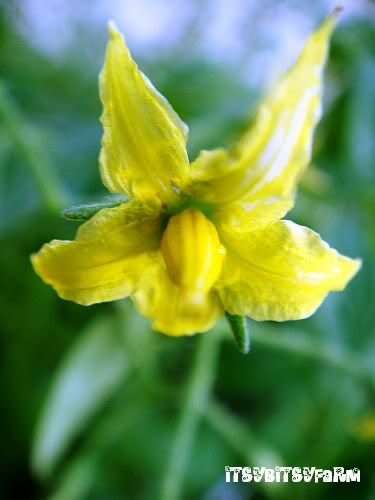 |
| tomato |
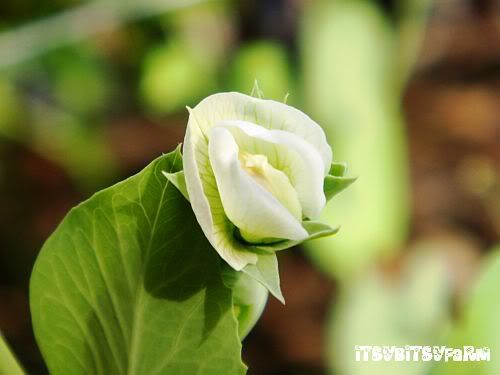 |
| peas |
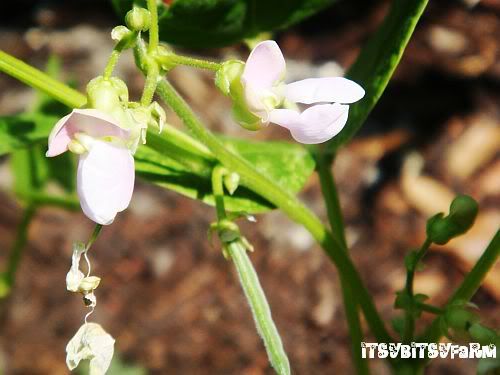 |
| bush beans |
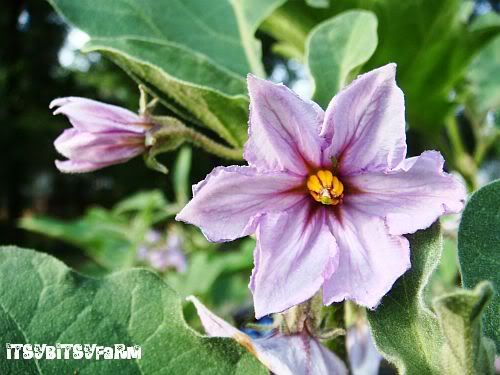 |
| eggplant |
 |
| asparagus yardlong |
 |
| zucchini |
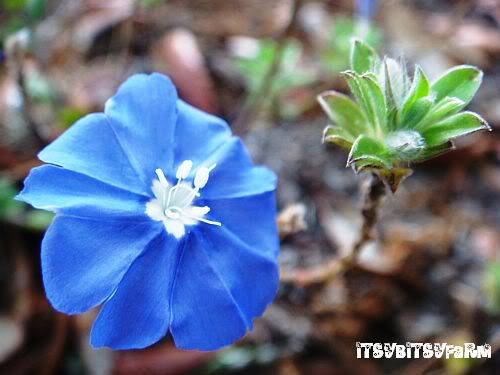 |
| blue daze early in the morning |
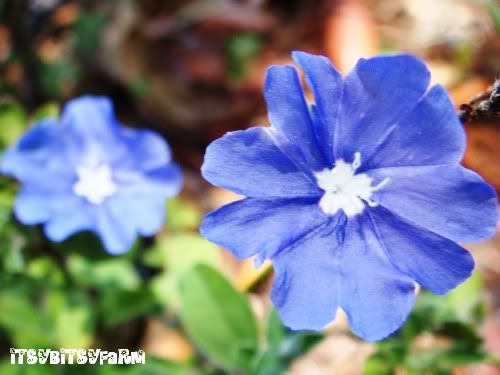 |
| another blue daze at noon |
 |
| mexican petunia |
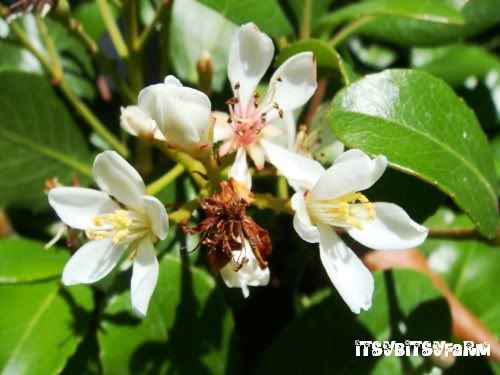 |
| indian hawthorne flower |
You see, I grew up in a very bucolic setting—in the midst of a sleepy farming village in the heart of Northern Philippines.
The lifestyle is very simple: fathers go out to the ricefields at 5:00 in the morning, mothers stay at home to tend to the children (or teach in the local public schools), grandparents spoil the kids with the occasional dirty ice cream treat, and kids climb trees and frolic in clear streams after school and during the weekend.
There’s not much trimmings in our daily lives, too. That meant no dinners out in fancy restaurants for the whole family. The only good restaurants were the ones for travelers, and the menu is equally no-frills rice and viands.
So no fancy expensive cut flowers on Valentine’s Day either...save perhaps the calabaza blooms that fathers usually bring home for a tasty vegetable soup called dinengdeng.
Growing up with that hefty dose of practicality at home and in the community, I didn’t think much of the beauty of flowers. The ones that I liked were meant for eating, not gazing at. The few times I saw boys give flowers to the girls they liked, I marveled at the waste of money that went with the gesture.
But I feel different now. I’ve begun to appreciate the biblical connotation to flowers—that God takes better care of us humans than the flowers in the field which, despite their stunning beauty, are gone in a flash.
And that is why, I don’t berate my husband anymore when he buys me beautiful long-stemmed golden roses for special days, heh.
Location:
Orange City, FL, USA
insects in my garden
I know some of them by name, the others by sight.
Photos not included:
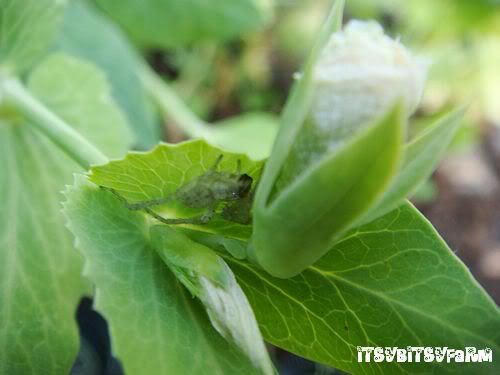 |
| green spider that's made it's home among my peas |
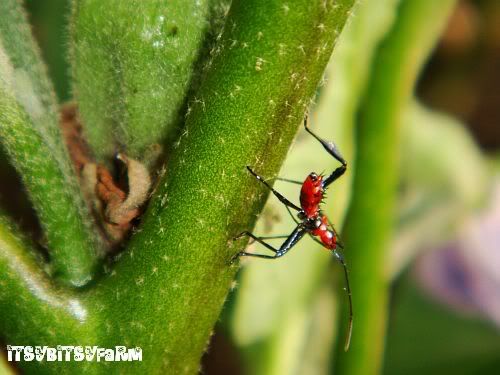 |
| this little critter hopped around my eggplants |
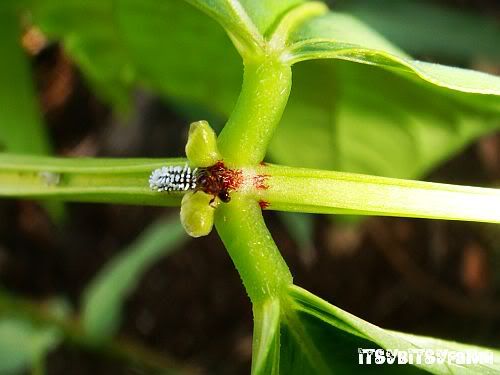 |
| the ant and whatcamacallit |
 |
| this one i actually know: an eastern lubber grasshopper. 30 or so of them were resting on my struggling gardenias a few days ago |
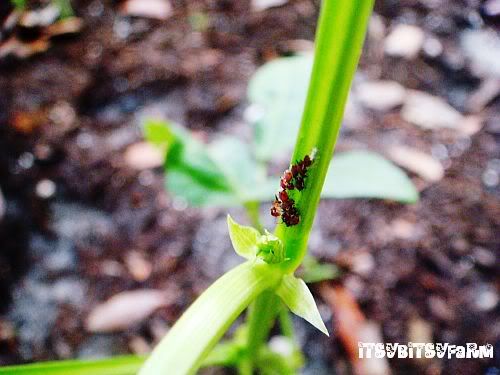 |
| ants, with some aphids |
- mosquitoes (because I can't stop myself from squishing them on sight, long enough to take pictures)
- butterflies (they fly off faster than I can grab my camera)
- green grasshoppers
- red ants
Subscribe to:
Comments (Atom)

